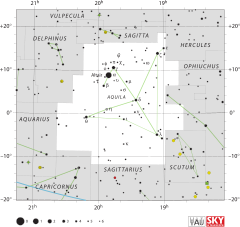| Observation data Epoch J2000 Equinox J2000 | |
|---|---|
| Constellation | Aquila |
| Right ascension | 19h 56m 14.25183s[1] |
| Declination | +11° 25′ 25.3931″[1] |
| Apparent magnitude (V) | +5.28[2] |
| Characteristics | |
| Spectral type | A1 IV[3] |
| U−B color index | –0.02[2] |
| B−V color index | +0.00[2] |
| Astrometry | |
| Radial velocity (Rv) | –27.2[4] km/s |
| Proper motion (μ) | RA: +32.826[1] mas/yr Dec.: +6.162[1] mas/yr |
| Parallax (π) | 14.1980 ± 0.1579 mas |
| Distance | 230 ± 3 ly (70.4 ± 0.8 pc) |
| Absolute magnitude (MV) | +1.14[5] |
| Orbit[6] | |
| Period (P) | 3.32068 days |
| Eccentricity (e) | 0.025 |
| Periastron epoch (T) | JD 2423210.628 |
| Argument of periastron (ω) (secondary) | 43° |
| Semi-amplitude (K1) (primary) | 37.2 km/s |
| Details | |
| A | |
| Mass | 2.39[7] M☉ |
| Radius | 1.8–2.5[8] R☉ |
| Luminosity | 34[5] L☉ |
| Surface gravity (log g) | 4.30[9] cgs |
| Temperature | 9,509[9] K |
| Metallicity [Fe/H] | +0.47[9] dex |
| Rotational velocity (v sin i) | 27[10] km/s |
| Age | 280[7] Myr |
| B | |
| Mass | 0.40[7] M☉ |
| Other designations | |
| Database references | |
| SIMBAD | data |
Phi Aquilae, Latinized from φ Aquilae, is the Bayer designation of a binary star[12] system in the equatorial constellation of Aquila. It has an apparent visual magnitude of +5.28[2] and is visible to the naked eye. With an annual parallax shift of 14.198 mas,[1] this star is located at a distance of approximately 230 light-years (71 parsecs) from Earth. It is drifting closer with a radial velocity of –27 km/s.[4] Based on its motion through space, this system is considered a possible member of the nearby Argus association of co-moving stars, although it may be too old.[13]
Phi Aquilae is a single-lined spectroscopic binary with an orbital period of 3.32068 days.[6] The pair have a projected separation of 190.4 AU as of 2008.[7] The primary component is a subgiant star with a stellar classification of A1 IV.[3] The star is around 280[7] million years old and is spinning with a projected rotational velocity of 27.[10] It has 2.39[7] times the mass of the Sun and somewhere in the range of 1.8–2.5[8] times the Sun's radius. The outer atmosphere has an effective temperature of 9,509 K,[9] giving it the white-hued appearance of an A-type star.[14] It is radiating 34[5] times the luminosity of the Sun.
The orbiting companion may be the source of the X-ray emission from this system, as stars similar to the primary component do not generally produce detectable levels of X-rays.[15] It has 40% of the mass of the Sun.[7]
- ^ a b c d e Cite error: The named reference
GaiaDR2was invoked but never defined (see the help page). - ^ a b c d Cite error: The named reference
aaass52_131was invoked but never defined (see the help page). - ^ a b Cite error: The named reference
aj74_375was invoked but never defined (see the help page). - ^ a b Cite error: The named reference
gcrv1953was invoked but never defined (see the help page). - ^ a b c Cite error: The named reference
Anderson2012was invoked but never defined (see the help page). - ^ a b Cite error: The named reference
aj76_544was invoked but never defined (see the help page). - ^ a b c d e f g Cite error: The named reference
De_Rosa_et_al_2014was invoked but never defined (see the help page). - ^ a b Cite error: The named reference
aaa367_521was invoked but never defined (see the help page). - ^ a b c d Cite error: The named reference
aaa515_A11was invoked but never defined (see the help page). - ^ a b Cite error: The named reference
aaa463_2_671was invoked but never defined (see the help page). - ^ Cite error: The named reference
SIMBADwas invoked but never defined (see the help page). - ^ Cite error: The named reference
mnras389_2_869was invoked but never defined (see the help page). - ^ Cite error: The named reference
Zuckerman2019was invoked but never defined (see the help page). - ^ Cite error: The named reference
csirowas invoked but never defined (see the help page). - ^ Cite error: The named reference
mnras415_1_854was invoked but never defined (see the help page).
